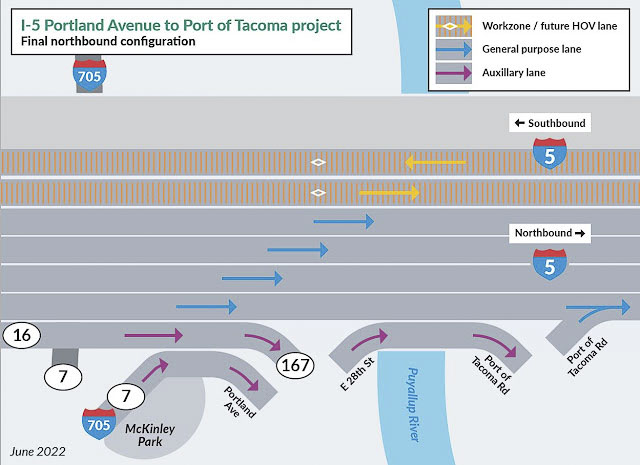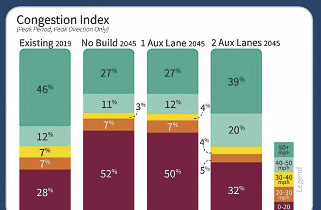WSDOT and ODOT data refute claim ‘you can’t build your way out of congestion’
John Ley
for Clark County Today
A nightmare of traffic congestion for commuters and freight haulers on I-5 has disappeared. One news report said: “It was as if the Washington Department of Transportation (WSDOT) just snapped its fingers or waved a magic wand. As soon as the new northbound lanes opened on June 26, the traffic just vanished.”
Yet Greg Johnson, administrator of the Interstate Bridge Replacement Program (IBR) says “you can’t build your way out of traffic congestion.” He was parroting WSDOT Secretary Roger Millar who told the IBR’s Executive Steering Group the same thing earlier in the project.
A new general-purpose lane was added to I-5. WSDOT communication consultant Cara Mitchell said a new auxiliary lane connecting the on and off-ramps in the area added a lot more room to merge. A total of two new lanes were added to this section of I-5.

Where is this “magical” place, where adding vehicle capacity for cars and freight haulers made traffic congestion disappear? Will Millar and Johnson change their tunes, now that Millar’s DOT has actually helped reduce traffic congestion on I-5?
The state added these two new lanes between the downtown Tacoma exits and Port of Tacoma Road on northbound I-5.
“There has been virtually no congestion from the corner by Highway 16 to Port of Tacoma Road ever since, and that includes a drive-through there Tuesday, July 5, in the middle of the afternoon,” reported KIRO’s Chris Sullivan. “I was shocked. I did not get below freeway speed on the day after a holiday when I would have normally been in a three-and-a-half mile, bumper-to-bumper mess.”
ODOT miracle too
I-5 near Tacoma isn’t the only location that adding a lane (or two) is projected to reduce or eliminate traffic congestion. The Oregon Department of Transportation (ODOT) is projecting a 12-hour reduction in traffic congestion on I-205 by 2045 after they add a new lane in each direction to I-205 as part of their Abernethy Bridge project.
It’s been 40 years since I-205 opened and vehicle capacity was added to the region. Clackamas County’s population has nearly doubled. The Abernethy Bridge is part of the only two-lane section of I-205 from Oregon City to the I-5 interchange.
By 2045, ODOT and its consultants expect traffic congestion to double to 14 hours daily, if nothing is done. Instead, the project will add lanes and tolling, and will significantly reduce congestion. There was no data provided on how much congestion reduction was due to the 50 percent increase in vehicle lanes, versus the proposed variable rate tolling proposed for I-205.
The dual initiative, adding lanes and tolling, would reduce traffic congestion to just two hours a day in the southbound direction. ODOT officials said the project would completely eliminate congestion in the northbound direction.
“The analysis found that drivers could see a 50 percent decrease in afternoon travel time and a 25 percent decrease in the morning,” ODOT officials said. “In addition, travel times would become more reliable, and the number of crashes would shrink, improving efficiency and safety.”
The best improvements by completing the project were in afternoon travel times. The northbound I-205 travel was 15 minutes faster, and southbound 7 minutes faster. Those time savings were measured from I-5 to the 82nd Drive exit in Gladstone. The best morning commute improvement was 4 minutes.
WSP USA consultant Chris Wellander commented on people’s willingness to pay tolls. “I think the thing about adding capacity and the improvements to 205, is that you’re improving the facility, you’re making it more attractive for people to use. They’re more willing to pay a toll in that case than if there was no improvement at all,”
Staff didn’t answer a citizen follow up question. “Chris said people are willing to pay tolls if there are ‘improvements,’ i.e. new lanes. Why wouldn’t this apply to I-5 tolls?”
KIRO news reporter Rick Sullivan drives I-5 in the Tacoma area highlighting that traffic congestion disappeared due to the added lanes WSDOT built on the interstate near the Tacoma Dome. Video courtesy KIRO
Interstate Bridge Replacement
On the I-5 IBR program, the Johnson team is recommending the addition of no new through lanes to the bridge or freeway. They will replace a three-lane bridge with another three-through lane bridge.
The IBR team wants to add only one auxiliary lane. Early on there was discussion of adding up to three auxiliary lanes to handle merging and weaving due to the numerous on and off ramps being discussed for the 5-mile bridge influence area.
If two auxiliary lanes had been added, an IBR analysis indicated traffic congestion would only increase from 28 percent to 32 percent. Instead, the single auxiliary lane recommendation will cause congestion to be 50 percent of I-5 traffic during rush hour.
Recent discussions among the 16 members of the Bi-state Bridge Committee of Oregon and Washington legislators brought push-back on there only being one auxiliary lane. Several legislators pushed for a “freight only” lane for the significant number of trucks transiting the region at their June 17 meeting.
Rep. Shelly Boshart Davis (Republican, Albany) owns a trucking company and has pushed hard for additional consideration of freight haulers. Sen. Lee Beyer (Democrat, Springfield) had previously noted that it will be hard to adjust the size of the bridge in 20 or 30 years, and the team should be focusing on the fact that this will be a 100-year asset.
Port of Vancouver Commissioner Jack Burkman recently asked the Regional Transportation Council (RTC) Board to consider requesting a focus on travel time improvements be given to the IBR team. He cited the number of trucks left idling in congested traffic as being bad for the environment, in addition to creating time problems for the freight haulers using both the Ports of Portland and Vancouver.
The net result of the IBR recommendation is that in 2045, they project travel times will double on I-5 between the Salmon Creek interchange and the I-405 Fremont Bridge interchange. Their data indicate average travel times are presently 29 minutes, and will become 60 minutes after the completion of the project.
Furthermore, they report 50 percent of vehicles will be stuck in traffic traveling zero to 20 miles per hour during commute times by 2045, nearly double the current condition.
Supposedly this increased I-5 congestion will be after the IBR spends an estimated $5 billion to replace the bridge, Oregon spends an estimated $1.4 billion at the Rose Quarter, and tolls are charged for using the new Interstate Bridge and a second toll is charged for using I-5 in Oregon.
Back in Tacoma, WSDOT is not finished with improvements to I-5. They are adding the direct High Occupancy Vehicle (HOV) lane access between state Route 16 and northbound I-5.
“Just imagine what that will do to this already improving drive,” Sullivan said. “This will eliminate the weaving from the SR 16 HOV lane, which is currently driving in the collector-distributor lane to its own direct HOV access ramp. That change should happen before the end of the month.”

Also read:
- Busy pavement season ahead on Vancouver streetsThe city of Vancouver is set to repave and preserve 76 lane miles across 20 neighborhoods in summer 2025, with ADA upgrades and community notices throughout.
- State representative: Expect sticker shock when Interstate Bridge project officials reveal price, tolling plansAt a town hall in Battle Ground, Rep. John Ley warned of major cost increases and tolling burdens tied to the Interstate Bridge replacement project.
- Opinion: Washington state lawmakers increase the cost of driving – againBob Pishue of Mountain States Policy Center argues that new vehicle and fuel taxes in Washington will raise driving costs while diverting funds away from roads.
- Overnight full closure of I-5 near Woodland for bridge inspection, May 6WSDOT will fully close southbound I-5 near Woodland overnight on Tuesday, May 6 for a bridge inspection using a chain drag test.
- Opinion: Do we still need TriMet?John A. Charles Jr. of the Cascade Policy Institute argues that TriMet should halt expansion plans and prepare for major service reductions in response to falling ridership and rising costs.










An I-5 replacement bridge or tunnel can easily gain another lane by eliminating a dedicated costly fixed track light rail system with electric overhead lines , and building instead another 12′ wide freeway lane shared by all vehicles, including buses and freight.
Transportation architect Kevin Peterson has pointed out that one vehicle lane can handle about 1,800 vehicles an hour. If that’s the case, it would seem public transit buses and vans could easily travel in a vehicle lane, alongside cars, buses, and freight. Public transit would only occupy at most 10 percent of the vehicle capacity one lane provides. Why not allow other vehicles to use that lane when buses are not present?
See ClarkCountyToday report on How much land will the interstate bridge replacement remove from I-5 for transit?
“All the Bus Rapid Transit options would need a normal 12-foot-wide freeway lane for real estate on both the bridge and on I-5.”
“On a city street, like running down Interstate Avenue or on the I-84 MAX line next to the freeway, there is roughly 35 to 40 feet required when two sets of tracks are put down, side by side. That’s the equivalent of three 12-foot vehicle lanes.”